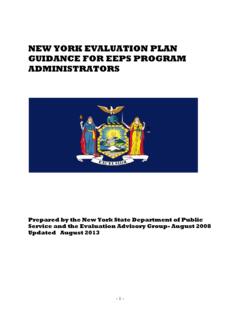Transcription of TRansformed Healthy Start Program Evaluation Plan
1 1 TRansformed Healthy Start Program Evaluation plan Program DESCRIPTION Improving pregnancy outcomes for women and children is one of the nation s top priorities. The infant mortality rate (IMR) is a widely used indicator of the nation s health. In 2013, the IMR was infant deaths per 1,000 live births. However, racial-ethnic disparities persist and in the same year, the IMR for infants born to non-Hispanic black mothers was , more than double the non-Hispanic white IMR of (Matthews, et al. 2015). The Healthy Start (HS) Program was created to address factors that contribute to the high IMR, particularly among African-American and other minority groups. The Program began in 1991 as a demonstration project with 15 grantees and has expanded over the past two decades to 100 grantees in 37 states and Washington, DC. The HS Program is administered by the Division of Healthy Start and Perinatal Services (DHSPS) within the Maternal and Child Health Bureau (MCHB) at the Health Resources and Services Administration (HRSA).
2 The Program is authorized under Title III, Part D, Section 330H of the Public Health Service Act (42 USC 254 c-8) and was reauthorized in 2014. The grant period for the TRansformed HS Program is September 2014 May 2019. While the Program has existed for over 20 years, the HS Program was TRansformed in 2014 to apply lessons from emerging research, past Evaluation findings, and to act on national recommendations from the Secretary s Advisory Committee on Infant Mortality (SACIM) ( ). With an emphasis on standardized, evidence-based approaches, the goal of the new HS Program is to improve maternal health outcomes and reduce disparities in perinatal outcomes in the US through evidence-based practices, community collaboration, organizational performance monitoring, and quality improvement. To achieve this goal, the HS Program employs five community-based approaches to service delivery and facilitates access to comprehensive health and social services for high risk pregnant women, infants, children (through the first two years of life) and their families in geographically, racially, ethnically, and linguistically diverse low income communities with exceptionally high rates of infant mortality.
3 Approximately half of all HS participants served are pregnant women. The five approaches are briefly described below. 1. Improve women s health. Facilitate and conduct outreach, screening and assessment, health education, insurance enrollment, and linkages to medical and other social resources for women before, during, and beyond pregnancy. 2. Promote quality services. Promote service coordination and systems integration across the life-course; conduct staff training to support core competencies and cultural competence; and use standardized and evidence-based curricula and interventions. 3. Strengthen family resilience. Address toxic stress and support trauma-informed care; provide linkages to mental and behavioral health; support Healthy relationships and male involvement; and empower women and their families to meet child developmental needs and cope with adversity.
4 4. Achieve collective impact. Convene a community action network to spur community mobilization and transformation in systems, policies, and environments; build social capital; and serve as a community hub to provide leadership in the community. 5. Increase accountability through quality improvement, performance monitoring, and Evaluation . Strengthen the monitoring and Evaluation capacity and infrastructure of HS to track and measure efficiency, effectiveness, quality, performance, and other key 2 outcomes for accountability, quality improvement, and Program improvement; and translate findings into practice to support sustainability of the Program within the larger context of the health care delivery and social service system. HS grantees engage in a number of activities including recruiting participants, conducting comprehensive screenings, enrolling participants in health coverage, developing reproductive life plans, providing health education and preventive services, providing case management and follow-up services, referring patients to primary health and social services, and promoting interconception care and male/father involvement.
5 Grantee activities also include collective impact efforts such as connecting to national MCH organizations, creating strategic action/work plans, and coordinating community services and data systems. HS grants are provided at three levels with an increasing expectation of service delivery and impact. The majority of HS grantees (n=60) are Level 1, Community-based HS programs , serving a minimum of 500 Program participants per year, and supporting implementation of essential activities under the five approaches. There are another 22 Level 2, Enhanced Services HS grantees, serving more participants (minimum 800) and engaging in Level 1 activities as well as additional activities to stimulate community collaboration. Lastly, there are 18 Level 3, Leadership and Mentoring HS grantees, serving the highest number of Program participants (minimum 1,000), and engaging in activities under both Levels 1 and 2, as well as additional activities to expand maternal and women s health services, develop place-based initiatives, and serve as centers to support other HS projects and organizations working towards improving perinatal outcomes.
6 Logic Models There are two logic models included in this Evaluation plan . The first is a Program logic model (Appendix A) that was developed in December 2014 in consultation with the HS Evaluation Technical Expert Panel (TEP), HRSA s Office of Research and Evaluation (ORE), and the HS contractor, JSI. The basis of the Program logic model is the TRansformed HS Program funding opportunity announcement (FOA). As noted in the Program logic model, the HS Program relies on a number of resources at the participant, Program /organization, and community levels. For example, resources such as social networks and partnerships, provider and service networks, MCH evidence-based interventions and related research, capacity building assistance, community leaders and priorities, community infrastructure and resources ( , childcare, housing, transportation) and policies at the Federal, state, and local levels all are essential to the implementation and conduct of HS activities.
7 Implementation of the Program s approaches and subsequent activities is expected to result in a number of outcomes. There are three levels of outcomes: 1) short-term; 2) intermediate; and 3) long-term/impact. Short-term outcomes can be observed within the first few years of project implementation, such as changes in knowledge, skills, motivation and health care utilization at the individual and family/social support levels and changes in access, systems development, and coordination at organizational, community, and systems levels. Intermediate outcomes occur after the Program has matured, usually 2 3 years after implementation, and include changes in Healthy behaviors; community, organizational, and systems capacity, quality, efficiency, and effectiveness; and active partnerships and networks. Long-term outcomes or impact often require more than 3-5 years to observe and are related to changes in health status (for example, morbidity and mortality), policies, and environment.
8 The Program logic model illustrates the specific components, pathways for change, and outcomes the Program is expected to achieve. The Evaluation team did not update the Program logic model because it is still reflective of the TRansformed HS Program and its Program guidance. However, to help communicate the 3 Evaluation aims and the data collection and analysis activities of the current Evaluation , the MCHB Evaluation team worked with ORE to develop a logic model for the HS Evaluation plan . The Evaluation plan logic model can also be found in Appendix A. The Evaluation plan logic model includes the data collection instruments, HS participants and partners, MCHB/HRSA staff and the HS Evaluation TEP as the inputs or resources. From here, the data collection instruments are linked to the three Evaluation components (implementation, utilization, and outcome evaluations) and the analysis activities for each component.
9 The outputs to be assessed by the Evaluation ( , types of activities, interventions, and services; Program and organizational factors; HS participant characteristics; and indicators of access to and use of HS services) are identified for the implementation and utilization evaluations. Additionally, the short, intermediate, and long-term outcomes to be assessed are identified for the outcome Evaluation . Examples of outcomes include: Short-term Outcomes enrollment in health insurance, use of social services, and development of reproductive life plans; Intermediate Outcomes Program alignment to the five HS approaches, differences in health behavior and health service utilization patterns, adoption of Healthy behaviors; and finally Long-term Outcomes decrease in low birthweight, infant mortality, and perinatal mortality. Throughout the Evaluation , continuous quality improvement will take place to improve both the Evaluation and programmatic activities.
10 Both the Program and Evaluation plan logic models are considered living documents and may be updated as new information about the Program and the Evaluation is revealed or the Program or the Evaluation focus shifts. PURPOSE OF THE Evaluation To understand the implementation and overall impact of the newly TRansformed HS Program , there is a need for a robust and comprehensive Evaluation . MCHB will conduct an Evaluation of the Program s implementation, utilization of HS services, and outcomes. Prior evaluations of HS (Devaney et al. 2000; Brand et al. 2010; Drayton et al. 2015; Health Resources and Services Administration 2006; Howell and Yemane 2006; Rosenbach et al. 2010) demonstrated some positive Program impact on participant satisfaction with the HS Program , knowledge, behaviors, access to services, integration of services, and maternal health care utilization.









